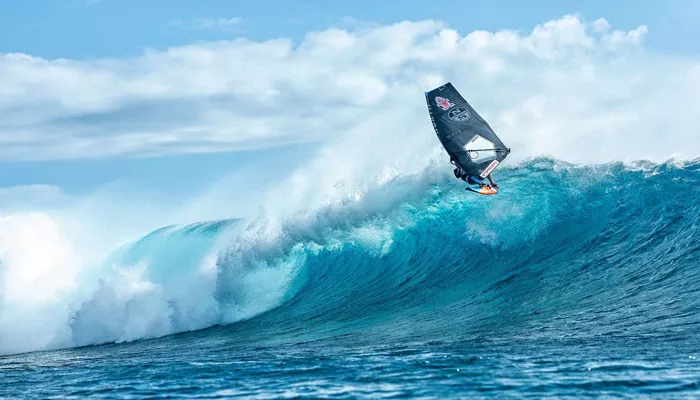Offshore wind surfing is a niche yet exhilarating variant of traditional windsurfing. It involves navigating away from the coastline, harnessing wind that blows from land out to sea. This form of windsurfing is not only physically demanding but also mentally stimulating. It combines elements of wind navigation, wave reading, and survival skills. Offshore wind surfing appeals to experienced surfers seeking greater freedom, speed, and adventure beyond the limits of coastal waves.
In this detailed guide, we’ll explore what offshore wind surfing is, the gear you need, safety protocols, training advice, location tips, and advanced techniques. Whether you’re an enthusiast or a beginner aiming to transition into offshore zones, this guide provides the essentials to ride safely and efficiently.
What Is Offshore Wind?
Offshore wind is wind that blows from land toward the sea. Unlike onshore wind, which pushes waves toward the beach, offshore wind flattens wave faces and blows surfers away from shore. In windsurfing, this means greater speeds and smoother surfaces but increased risk, as returning to shore becomes more challenging.
Defining Offshore Wind Surfing
Offshore wind surfing refers to windsurfing sessions in areas where the primary wind direction is from land to sea. Surfers often launch from a beach, then sail outward into open water. The objective is to harness strong, consistent offshore winds to gain speed, perform maneuvers, and explore distant wave zones.
Key Differences from Traditional Windsurfing
- Higher risk due to distance from shore
- Need for superior navigation and self-rescue skills
- Advanced wind prediction and reading capabilities
- Use of GPS and emergency communication devices
Essential Gear for Offshore Wind Surfing
Having the right equipment is critical when heading into offshore wind conditions. Here’s what you need:
Windsurf Board
Choose a freeride or slalom board for speed and stability. These boards are longer, faster, and designed for consistent wind rather than wave trick execution.
Sail Selection
Opt for a sail that matches wind speed. Cambered sails provide more control and are ideal for offshore wind consistency. Sizes range from 5.0 to 8.0 depending on wind strength and surfer weight.
Harness and Lines
Waist or seat harnesses distribute load, allowing for longer sessions. Adjustable harness lines enhance comfort and control in variable wind strength.
Wetsuit and Floatation
A 4/3mm or thicker wetsuit is ideal for colder offshore conditions. Integrated buoyancy aids increase safety. Consider impact vests for added protection.
Communication and Safety Tools
- GPS tracker with return-to-shore function
- Waterproof VHF radio or cell phone in dry pouch
- Flare or visual signaling device
- Small survival kit with knife and repair tape
Choosing the Right Offshore Location
Not all coasts are suited for offshore wind surfing. Ideal spots have consistent offshore wind, safe launch points, and minimal boat traffic. Examples include:
- Maui’s north shore (early morning offshore trades)
- Western Australia’s coastal cliffs
- Canary Islands (winter offshore winds)
- Portugal’s western coastline
What to Consider
- Wind strength and direction consistency
- Wave shape and period
- Distance to nearest safety or patrol station
- Presence of rips, reefs, or strong currents
Reading Wind and Wave Conditions
Success offshore begins with understanding forecasts and reading the sea:
Wind direction: Should be steadily offshore with low gust variability.
Wind speed: Ideal between 15–30 knots for intermediate to advanced riders.
Swell period: Longer periods (10–14s) mean cleaner, bigger waves offshore.
Use platforms like Windy, Windguru, and NOAA for up-to-date marine wind reports.
Safety Protocols And Emergency Planning
Offshore wind surfing requires strong self-reliance. Have a thorough emergency plan.
Solo or Partnered?
Always go with a buddy or inform someone of your route and return time. Track each other via GPS.
Rescue Strategy
- Have a clear plan for downwind recovery
- Use a paddle or collapsible oar in case of rig failure
- Mark route checkpoints and know maritime radio channels
Self-Rescue Skills
- Waterstarting in chop and swell
- Rig repair on water
- Board-only paddling (if sail is lost)
Training for Offshore Success
Skill progression is essential. Start with coastal training, then gradually move to deeper waters.
Master Coastal Winds First
Spend at least 1–2 years in cross-shore and side-shore conditions. Practice jibes, tacks, and waterstarts confidently before heading offshore.
Simulate Emergencies
Drop your rig intentionally. Practice recovering in waves. Sail back from deep water under challenging wind angles.
Advanced Offshore Techniques
Downwind Runs
Used to gain distance quickly, but harder to return from. Combine downwind with zigzagging upwind legs to return efficiently.
High-Speed Carving
Use offshore wind stability to perform high-speed jibes, carving turns, and spray arcs over clean wave faces.
Jumping and Wave Riding
Look for outside reef breaks. Jump over wind-swept swell. Ride long, groomed waves with minimal chop interference.
Physical And Mental Preparation
Being offshore is demanding. You must be fit and focused.
Strength: Upper-body endurance and grip strength are essential.
Cardio: Practice swimming and open-water paddling.
Mental: Stay calm during rig failures, falls, and changing conditions.
Environmental Awareness
Offshore zones are more isolated. Respect marine life and avoid protected areas. Use biodegradable wax and gear care products. Avoid fishing zones and shipping lanes.
Common Mistakes to Avoid
- Overestimating your skill or underestimating wind strength
- Leaving without communication gear
- Ignoring swell forecasts
- Not checking tide conditions
Legal Considerations And Permits
In some coastal nations, sailing offshore requires permits. Check maritime rules. In high-traffic zones, you may need to log departure with the coast guard.
Offshore Surfing Community
Join forums and communities. Offshore wind surf groups exist in Australia, Spain, Hawaii, and South Africa. Sharing GPS routes, tips, and safety alerts enhances both your skill and safety.
Conclusion
Offshore wind surfing is more than a sport. It’s a test of skill, endurance, and judgment. With the right preparation, gear, and mindset, it becomes a rewarding and freeing experience. This guide offers the foundation. The rest comes from experience on the open sea.

